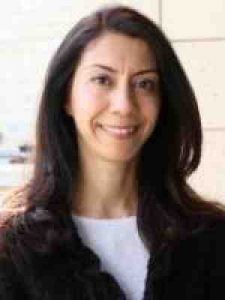August 25, 2018
Women’s Equality Week Q&A with Newsha Ajami
Posted by Timia Crisp
For the entire week, we are celebrating prominent female figures in science and science policy to recognize Women’s Equality Day on 26 August.
 Today, we are delighted to feature Dr. Newsha K Ajami. Dr. Ajami is the Director of Urban Water Policy at Stanford University. Dr. Ajami is also a Gubernatorial appointee to the Bay Area Regional Water Quality Control Board, a regulatory body that oversees protection of our California’s water resources in the Bay Area Region. Ajami received her Ph.D. in Civil and Environmental Engineering from University of California, Irvine.
Today, we are delighted to feature Dr. Newsha K Ajami. Dr. Ajami is the Director of Urban Water Policy at Stanford University. Dr. Ajami is also a Gubernatorial appointee to the Bay Area Regional Water Quality Control Board, a regulatory body that oversees protection of our California’s water resources in the Bay Area Region. Ajami received her Ph.D. in Civil and Environmental Engineering from University of California, Irvine.
Who or what has inspired you to pursue your research? Being where I am right now, it is hard to claim a single person or event inspired me. I believe success comes from the combination of being curious and open-minded, having the right mentors, not being afraid to take chances and explore new frontiers. My initial inspiration to become an engineer came from my maternal grandfather who was a railroad engineer and a philanthropist. After his retirement I would spend hours and hours of my summer vacation in his workshop, watching him work on his philanthropical projects using his engineering skills. My appreciation for sustainable resource management was also instilled in me during my childhood. Growing up in Tehran, Iran during the Iran-Iraq war, water and energy shortage was a real thing. Demand management and public awareness was a center piece in dealing with scarcity.
My love for public policy and applied interdisciplinary research came later and was inspired by my studies at the University of Arizona which covered the breadth and depth of hydrology and water resources field. Later, I took this interest and pursued the field of science policy through a series of fellowships ranging from a 10-day American Meteorological Society Science Policy colloquium to a one-year fellowship with the California State Legislature. These fellowships shaped my knowledge on how to work in the intersection of science and policy and inspired my interdisciplinary research agenda.
What is an obstacle you have had to overcome to get to your current position? I am an engineer and scientist by training, with extensive expertise in environmental management, policy, and governance. Most of my research from the very beginning has been interdisciplinary introducing system level thinking and policy analysis into hydrologic and environmental modeling to solve real-world problems. I focus a lot on developing long-lasting partnerships with decision and policy makers and in close collaboration with them craft research projects that would address some of their on-hand problems while developing and applying state-of-the-art and innovative methodologies. Unfortunately, this has not been a common practice in academia, and I certainly had and still have to overcome many hurdles in my career to demonstrate the worthiness and value of our research. Luckily, many of our projects have been highlighted by the media or used as a basis to policy and regulatory efforts which makes my team and I feel quite proud of our efforts. Fortunately, there is also more recognition of interdisciplinary and applied research and now a days a number of universities have started new programs with broader cross-disciplinary focus. However, there is still a long way to go as the internal culture of some of these organizations are not always as supportive of these changes.
Did you have any important mentors in your career, and how did they impact you? Yes! Many people have played a role in enabling me and supporting my career. They encouraged me, thought me to be open minded, curious, and resilient. Instead of showing me the way, they help me to think critically and see beyond the next step. Just to name a few people who mentored and supported me throughout my career: Professors Soroosh Sorooshian, John Dracup, Dave Sunding. All three provided me with valuable career advice, listened to my cares and concerns, always encouraged me and provided me with opportunities. Their support was especially valuable to me as a young mother with high professional ambitions. During my policy adventure, Mary Liu, Katharine Moore, Phil Isenberg and the entire Senator Fran Pavley’s and Senate Natural Resources and water committee team, played an invaluable role in mentoring me. Working at the legislature as a science and policy fellow was a very different and new experience for me and I needed lots of mentoring and advice to make it a valuable and effective experience for me while trying to be useful to the team I was working with.
I also want to note that my biggest fan and mentor has always been my mother who raised me gender blind and thought me to be fearless, open-minded and resilient.
What should be the future priorities for scientific research in the U.S.? No single discipline can help us reach a sustainable and resilient future. It is important to encourage broader and more integrated thinking. Our 21st century environmental challenges, including water and energy security and climate change, requires a generation of capable thinkers with a great ability to bring an interdisciplinary perspective. Encouraging more cross pollination among humanities, engineering and natural sciences is essential to building holistic solutions to our current challenges while guaranteeing long-term environmental sustainability.








